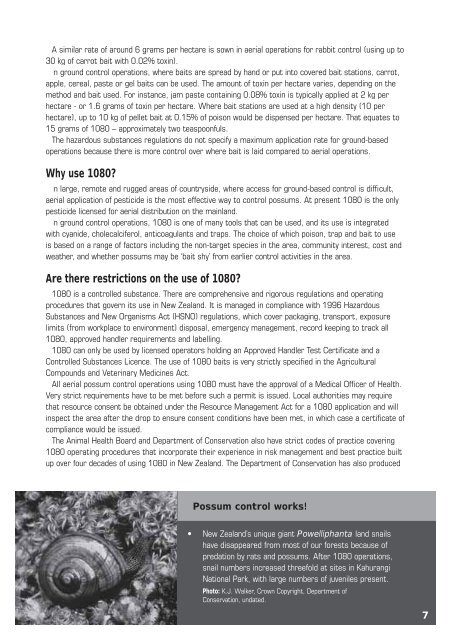National Possum Control Agencies - Department of Conservation
National Possum Control Agencies - Department of Conservation
National Possum Control Agencies - Department of Conservation
You also want an ePaper? Increase the reach of your titles
YUMPU automatically turns print PDFs into web optimized ePapers that Google loves.
A similar rate <strong>of</strong> around 6 grams per hectare is sown in aerial operations for rabbit control (using up to<br />
30 kg <strong>of</strong> carrot bait with 0.02% toxin).<br />
In ground control operations, where baits are spread by hand or put into covered bait stations, carrot,<br />
apple, cereal, paste or gel baits can be used. The amount <strong>of</strong> toxin per hectare varies, depending on the<br />
method and bait used. For instance, jam paste containing 0.08% toxin is typically applied at 2 kg per<br />
hectare - or 1.6 grams <strong>of</strong> toxin per hectare. Where bait stations are used at a high density (10 per<br />
hectare), up to 10 kg <strong>of</strong> pellet bait at 0.15% <strong>of</strong> poison would be dispensed per hectare. That equates to<br />
15 grams <strong>of</strong> 1080 – approximately two teaspoonfuls.<br />
The hazardous substances regulations do not specify a maximum application rate for ground-based<br />
operations because there is more control over where bait is laid compared to aerial operations.<br />
Why use 1080?<br />
In large, remote and rugged areas <strong>of</strong> countryside, where access for ground-based control is diffi cult,<br />
aerial application <strong>of</strong> pesticide is the most effective way to control possums. At present 1080 is the only<br />
pesticide licensed for aerial distribution on the mainland.<br />
In ground control operations, 1080 is one <strong>of</strong> many tools that can be used, and its use is integrated<br />
with cyanide, cholecalciferol, anticoagulants and traps. The choice <strong>of</strong> which poison, trap and bait to use<br />
is based on a range <strong>of</strong> factors including the non-target species in the area, community interest, cost and<br />
weather, and whether possums may be ‘bait shy’ from earlier control activities in the area.<br />
Are there restrictions on the use <strong>of</strong> 1080?<br />
1080 is a controlled substance. There are comprehensive and rigorous regulations and operating<br />
procedures that govern its use in New Zealand. It is managed in compliance with 1996 Hazardous<br />
Substances and New Organisms Act (HSNO) regulations, which cover packaging, transport, exposure<br />
limits (from workplace to environment) disposal, emergency management, record keeping to track all<br />
1080, approved handler requirements and labelling.<br />
1080 can only be used by licensed operators holding an Approved Handler Test Certifi cate and a<br />
<strong>Control</strong>led Substances Licence. The use <strong>of</strong> 1080 baits is very strictly specifi ed in the Agricultural<br />
Compounds and Veterinary Medicines Act.<br />
All aerial possum control operations using 1080 must have the approval <strong>of</strong> a Medical Offi cer <strong>of</strong> Health.<br />
Very strict requirements have to be met before such a permit is issued. Local authorities may require<br />
that resource consent be obtained under the Resource Management Act for a 1080 application and will<br />
inspect the area after the drop to ensure consent conditions have been met, in which case a certifi cate <strong>of</strong><br />
compliance would be issued.<br />
The Animal Health Board and <strong>Department</strong> <strong>of</strong> <strong>Conservation</strong> also have strict codes <strong>of</strong> practice covering<br />
1080 operating procedures that incorporate their experience in risk management and best practice built<br />
up over four decades <strong>of</strong> using 1080 in New Zealand. The <strong>Department</strong> <strong>of</strong> <strong>Conservation</strong> has also produced<br />
<strong>Possum</strong> control works!<br />
• New Zealand’s unique giant Powelliphanta land snails<br />
have disappeared from most <strong>of</strong> our forests because <strong>of</strong><br />
predation by rats and possums. After 1080 operations,<br />
snail numbers increased threefold at sites in Kahurangi<br />
<strong>National</strong> Park, with large numbers <strong>of</strong> juveniles present.<br />
Photo: K.J. Walker, Crown Copyright, <strong>Department</strong> <strong>of</strong><br />
<strong>Conservation</strong>, undated.<br />
7

















